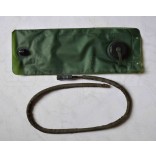Details
Rucksacks
Built to last, load carrying rucksacks and also built for comfort. Probably the most versatile element in the PLCE (Personal Load Carrying Equipment) they are the perfect bags for police, tactical operators, military personnel, cadets and active civilians alike. Rucksacks allow you to carry all your equipment, gear and books while allowing you to attach and detach your favourite pouches and gear. There are three main types of rucksacks namely frameless, external frame and internal frame. External and internal frame packs share the popularity among ruck sack owners.
The external frame packs are designed to carry heavy loads (more than 20kg or 40lbs). This gives the wearer more support and protection and better weight distribution than a simple, frameless strapped bag. Military packs are often external frame designs due to their ability to carry loads of different shapes, sizes and weights. Internal frame pack has a large fabric section around an internal frame composed of strips of aluminium, titanium or plastic and a complex series of straps to distribute the weight and hold it in place. It permits the pack to fit closely to the wearer’s back and minimizes shifting of the load. However, with the internal frame packs, the tight fit reduces ventilation, so these types tend to make the person sweatier than an external frame pack. They have features such as padded shoulder straps and top carry handle for easy transport. The rough and ragged built rucksacks will withstand the harshest abuse in the battlefield or while camping without slowing you down.
Multi-day packs typically have contents between 60 and 100 litres (and are about 3ft/1metre tall). Day packs hold supplies for a single day’s hiking (size about 20-30 litres). ‘ Weekender’ packs can hold up two or three days’ worth of gear and supplies (40-50 litres). Larger packs are designed to distribute the weight of increased numbers of gear and supplies for longer duration trips (60-100 litres).
Rucksacks are a standard part of the load-bearing equipment of soldiers. Well known examples include the US ALICE field pack and the British Army PLCE Rucksack attachment, such packs are most times external frame packs. Units entering combat situation rucksack may be heavily loaded and can weigh in excess of 100lbs. Each sack may carry extra weapon, ammunitions, ration, medical supplies, tents or other shelter material and extra clothing.
Packing your rucksack- Light gear such as spare clothing, sleeping bag goes to the bottom; medium gear such as canteen and food goes in next and the heavy gears such as tent, stove and fuel goes to the top. This is to be done so as to ensure the load on the back be distributed so that its weight is applied vertically down the length of the spine or upon the hips, rather than hanging off from the shoulder so you do not feel like u falling forward on your face when you begin to walk with it.
Putting a rucksack on-Never raise rucksack from the ground and then onto the shoulder when your knees are extended. First, raise the rucksack with the carrying grip and slip into one shoulder strap and then into the other. If you can’t raise the rucksack, you can lift it onto your thigh and then bring it into carrying position.
Additional Information
| size | N/A |
|---|
You may also be interested in the following product(s)
-

Hydration Reservoir
$19.99 -

PLCE Webbing
$68.88




